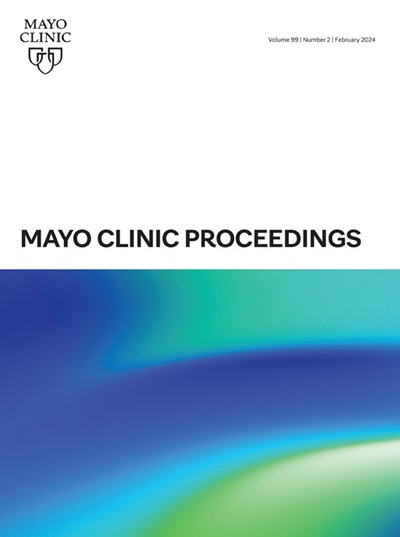使用羟苯磺酸钠的嗜睡症患者新发高血压的风险增加:一项真实世界研究。
IF 6.9
2区 医学
Q1 MEDICINE, GENERAL & INTERNAL
引用次数: 0
摘要
目的比较正常血压的嗜睡症患者开始服用羟丁酸钠(SXB 队列)与未开始服用羟丁酸钠(对照队列)之间新发高血压的中期风险:这项回顾性队列研究使用了 2014 年 1 月 1 日至 2020 年 2 月 29 日的 MarketScan 行政索赔数据。符合条件的患者年龄在 18 岁或 18 岁以上,连续注册(进入队列前后≥180 天),有一份或多份嗜睡症理赔申请或开具过羟贝特钠处方,无高血压或抗高血压药物使用史,且在进入队列前 13 个月内未使用过羟贝特钠。为平衡基线特征,SXB 和对照组患者按倾向得分 1:2 进行匹配。终点为:(1) 新发高血压诊断或开始服用降压药;(2) 新发高血压诊断。对患者进行为期 180 天的监测,直至出现结果、停用羟苯磺酸钠(SXB 队列)或开始使用羟苯磺酸钠(对照队列)。报告了每 100 例患者的风险;使用逻辑回归估算调整后的几率比(OR)和 95% 置信区间(CI)来评估差异:结果:SXB 和对照组分别包括 954 名和 1908 名患者。与对照组相比,SXB 组群中新发高血压诊断或开始服用降压药的风险更高(每 100 例患者中有 6.60 例与 4.20 例;OR,1.61;95% CI,1.15 至 2.27)。仅在 SXB 队列中,每 100 名患者中新诊断出高血压的风险为 0.94,而在对照队列中,每 100 名患者中新诊断出高血压的风险为 0.52(OR,1.81;95% CI,0.73 至 4.46):在这项研究中,使用羟苯甲酸钠与血压正常的嗜睡症患者被诊断为新发高血压或开始服用降压药有关。本文章由计算机程序翻译,如有差异,请以英文原文为准。

Increased Risk of New-Onset Hypertension in Patients With Narcolepsy Initiating Sodium Oxybate: A Real-World Study
Objective
To compare intermediate-term risk of new-onset hypertension between normotensive patients with narcolepsy initiating sodium oxybate (SXB cohort) and those not initiating sodium oxybate (control cohort).
Patients and Methods
This retrospective cohort study used MarketScan administrative claims data from January 1, 2014, to February 29, 2020. Eligible patients were 18 years of age or older with continuous enrollment (≥180 days before and after cohort entry), had one or more narcolepsy claims or a prescription fill for sodium oxybate, had no history of hypertension or antihypertensive medication use, and had no use of sodium oxybate within 13 months before cohort entry. Patients in the SXB and control cohorts were matched 1:2 for the propensity score to balance baseline characteristics. End points were (1) a composite of new-onset hypertension diagnosis or antihypertensive medication initiation and (2) new-onset hypertension diagnosis. Patients were monitored for 180 days, until outcome occurrence, sodium oxybate discontinuation (SXB cohort), or sodium oxybate initiation (control cohort). Risk per 100 patients was reported; differences were evaluated using logistic regression to estimate adjusted odds ratios (ORs) and 95% confidence intervals (CIs).
Results
The SXB and control cohorts included 954 and 1908 patients, respectively. Risk of new-onset hypertension diagnosis or antihypertensive medication initiation was higher in the SXB cohort than in the control cohort (6.60 vs 4.20 per 100 patients; OR, 1.61; 95% CI, 1.15 to 2.27). Risk of a new-onset hypertension diagnosis only in the SXB cohort was 0.94 per 100 patients and 0.52 per 100 patients in the control cohort (OR, 1.81; 95% CI, 0.73 to 4.46).
Conclusion
In this study, sodium oxybate use was associated with a new-onset hypertension diagnosis or antihypertensive medication initiation in normotensive patients with narcolepsy.
求助全文
通过发布文献求助,成功后即可免费获取论文全文。
去求助
来源期刊

Mayo Clinic proceedings
医学-医学:内科
CiteScore
16.80
自引率
1.10%
发文量
383
审稿时长
37 days
期刊介绍:
Mayo Clinic Proceedings is a premier peer-reviewed clinical journal in general medicine. Sponsored by Mayo Clinic, it is one of the most widely read and highly cited scientific publications for physicians. Since 1926, Mayo Clinic Proceedings has continuously published articles that focus on clinical medicine and support the professional and educational needs of its readers. The journal welcomes submissions from authors worldwide and includes Nobel-prize-winning research in its content. With an Impact Factor of 8.9, Mayo Clinic Proceedings is ranked #20 out of 167 journals in the Medicine, General and Internal category, placing it in the top 12% of these journals. It invites manuscripts on clinical and laboratory medicine, health care policy and economics, medical education and ethics, and related topics.
 求助内容:
求助内容: 应助结果提醒方式:
应助结果提醒方式:


